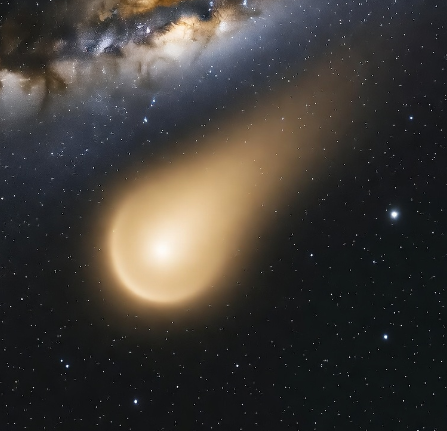
3I/ATLAS: Interstellar Visitor or Extraterrestrial Enigma?
In the vast expanse of the cosmos, where stars whisper secrets across light-years, few events capture the human imagination like an uninvited guest from beyond our solar system. Enter 3I/ATLAS, the third confirmed interstellar object to breach our celestial borders, discovered on July 1, 2025, by the Asteroid Terrestrial-impact Last Alert System (ATLAS) telescope in Río Hurtado, Chile.
Dubbed a comet due to its icy nucleus and ethereal coma, this wanderer hurtles through space at an astonishing 58 km/s relative to the Sun—faster than its predecessors, 1I/ʻOumuamua and 2I/Borisov—boasting an orbital eccentricity exceeding 6, a hyperbolic path that screams “outsider.”
But as telescopes swivel and scientists scramble, whispers on social media and fringe forums ignite: Is 3I/ATLAS merely a frozen relic, or an alien craft poised to rendezvous with Earth?The object’s journey is a saga of cosmic isolation. Simulations tracing its backward trajectory suggest it originated near the Milky Way’s Galactic Center in Sagittarius, possibly ejected from a primordial planetesimal disk billions of years ago.
For up to 10 billion years, it has roamed interstellar void, a time capsule battered by radiation, preserving chemistry from an era when the universe was young and wild.
NASA’s Hubble and James Webb Space Telescopes, alongside ESA’s ExoMars Trace Gas Orbiter and Mars Express, have captured its glow: a nucleus roughly 5.6 kilometers wide, massing over 33 billion tons, anomalously massive compared to its interstellar kin.
Spectral analysis reveals a bounty of water ice, carbon dioxide, and metallic elements, with hydroxyl (OH) emissions detected far from the Sun—over three astronomical units away—hinting at volatile ices sublimating prematurely, like a cosmic fire hydrant unleashed.
“Every interstellar comet so far has been a surprise,” notes researcher Zexi Xing, underscoring the object’s deviant behavior.
Yet, in the shadow of these revelations, speculation brews. ʻOumuamua’s anomalous acceleration—deviating from pure gravity without visible jets—sparked Harvard’s Avi Loeb to propose it as solar-sail debris from an alien probe.
3I/ATLAS, with its negligible non-gravitational nudge and “tail-like elongation” observed on July 2, 2025, echoes that mystery.
Online theorists, from Reddit ufologists to X (formerly Twitter) doomsayers, amplify the buzz: its speed (245,000 km/h), southern trajectory opposing the solar apex, and metallic richness scream artificiality. “A galactic courier from an advanced civilization?” posits one viral thread, likening it to a probe scouting habitable worlds.
Brian Cox, the physicist, finds its antiquity “remarkable,” but cautions against anthropomorphism—it’s likely a natural ejecta, a frozen snapshot of exoplanetary birth.
The trajectory debunks doomsday dreams. Perihelion looms in late October 2025, but Earth’s closest brush is a safe 1.8 AU—170 million miles—ensuring no touchdown, no invasion.
ESA’s JUICE spacecraft will image it near Jupiter in November, as it slingshots outward, bound for the stars once more.
No landing, no contact; just data, tantalizing and fleeting.Still, 3I/ATLAS stirs existential awe. Interstellar objects like it—estimated at trillions in the galaxy—pepper the void, potential vectors for life’s ingredients, seeding worlds with organics.
If alien craft they be, their “arrival” is metaphorical: a reminder we’re not alone in the narrative of the universe. Physicist Dennis Bodewits calls detecting its water “reading a note from another planetary system.”
Natural or engineered, it challenges our isolation, urging telescopes skyward.As 3I/ATLAS fades from view, eclipsed by the Sun until late November, humanity grapples with the thrill of the unknown. In an age of exoplanet hunts and SETI scans, this comet isn’t crashing to Earth—it’s crashing through our worldview. Perhaps that’s the true arrival: not a vessel from ET, but a mirror reflecting our cosmic curiosity. For now, science prevails over sci-fi, but the stars keep their secrets. Who knows what the fourth will bring?
